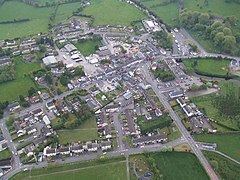Population 972 (2001 Census) Dialling code 02868 Local time Sunday 3:07 PM | Sovereign state United Kingdom Postcode district 93 Province Ulster | |
 | ||
Weather 9°C, Wind W at 23 km/h, 68% Humidity UK parliament constituency | ||
Kesh (from Irish Ceis, meaning 'wicker bridge') is a village in County Fermanagh, Northern Ireland. It is on the Kesh River about 1 mile (1.6 km) from Lower Lough Erne. The 2001 Census recorded a population of 972 people. It is within Fermanagh and Omagh district.
Contents
- Map of Kesh Enniskillen UK
- Name
- Crevenish Castle
- The Troubles
- Slaters Directory 1870
- Local attractions
- Kesh Primary School
- Notable Kesh connections
- Transport
- 2001 census
- References
Map of Kesh, Enniskillen, UK
Because of its location close to Lough Erne the village has been a popular tourist resort. It has two caravan parks, a small attractive marina and other related industries both within its boundaries and the surrounding area. It is about 5 miles (8 km) from the border with the Republic of Ireland and 22 miles (35 km) from the Atlantic coast resort of Rossnowlagh in County Donegal, thus adding to its popularity with holiday makers, day-trippers and weekenders.
Name
The toponym Kesh comes from 'ceis', the Irish word for 'wicker bridge', which refers to the crossing in the middle of the village. The village is not built around a parish church or chapel. Two Church of Ireland parishes of Magherculmoney and Tubrid meet at the river and their respective parish churches are each about 2 miles (3 km) either side of the village.
Kesh began as a ford or crossing place on the Glendarragh River. In the past Lough Erne came very much closer to the village than it does today. Before the first great Erne Drainage in the 1880s the lake was about eight feet higher and especially in time of flood may almost have reached Kesh. The rath on Rosscah Hill above the late Joe Robert's house, (a former rectory of Drumkeeran Parish) indicates original settlement here probably as far back as the Iron Age c 2000 years ago. There are two raths on this hill but the nearer to the house is believed to be a decorative feature made at the time of the construction of the house in the late 1700s. The large standing stone in Rosculban may be a relic of the Iron Age as well.
After a time the ford was augmented with a wicker bridge for which the Gaelic word is ceis and hense the village got its name. The name had been spelt in varying ways but generally as Kish or Cash until relatively modern times. An ancient saying in the locality which may refer to basket making and osier working in the area states that anyone gifted with a big behind, "had an ass on them like a Kesh creel."
Crevenish Castle
The remains of Crevenish Castle are south-east of the village on the Crevenish Road, or 'the back road' as the locals call it. During its time it was home to the Blennerhasset and Maguire families in the 1600 and 1700s.
The Troubles
For more information see The Troubles in Kesh, which includes a list of incidents in Kesh during the Troubles resulting in two or more fatalities.
Slater's Directory 1870
This information from Slater's Directory of 1870 tells of the economic activity about Kesh at that time.
Local attractions
Kesh Primary School
The date the school was established is unknown but the Clogher Records record a school in Kesh, Rosscolban in 1820 beside the schoolmaster's house. The original building was built in 1865 (as marked on the memorial stone on the front of the school). In 1957, the Right Hon Edward Archdale paid for the renovation of the school of 1 classroom making it into 3 classrooms and a PE hall. Many children were demanding enrolment as a result of the closure of other rural schools in 2001 WELB decided to build a new school. Building started in 2006 and the same year the school was ready to intake an average of 200 children.
Notable Kesh connections
Transport
Kesh railway station on the Enniskillen and Bundoran Railway was opened on 13 June 1866 and closed on 1 October 1957.
The greatest impetus ever provided to Kesh was the arrival of the railway in 1866. It provided employment and a focus for traffic to and from the station. Hardware shops and shops providing for the needs of farmers could now carry a greater variety of goods and stock could be replenished more quickly than by horse and cart. Cattle and other livestock could also be transported to distant markets after being bought in local fairs such as Ederney and Lack itself. Butter and eggs could be produced in greater quantities and markets in Belfast and Dublin easily reached by train. Another boon to Kesh was the establishment of the Creamery there although this was done against much local opposition.
Ulsterbus routes 194 (Enniskillen to Pettigo) and 83A (Omagh to Kesh) stop in Kesh
2001 census
Kesh is classified as a small village or hamlet by the NI Statistics and Research Agency (NISRA) (i.e. with population between 500 and 1,000). On Census day (29 April 2001) there were 972 people living in Kesh. Of these:
For more details see: NI Neighbourhood Information Service
